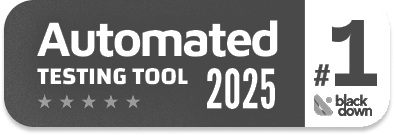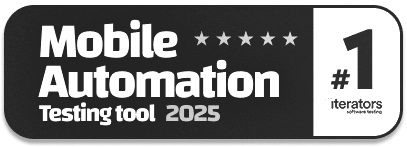Record and Playback Testing in 2025
|
|
“I see no reason for recording the obvious” – Edward Weston.
This quote is about photography, but when discussing record-and-playback tools, we do not even want to miss a single click. Record and playback testing has been around for a long time and, along the way, has established its own niche and reputation among software teams who have been using it over the years. However, the record and playback market has changed significantly in recent years, leading many teams to take a fresh look at it.
Since you may be wondering whether or not this form of testing has finally evolved to the point where it makes sense for your team to adopt it, we’ve prepared a quick overview to get you up to speed on the current state of the record and playback testing in 2025.
What is Record and Playback Testing?
Record and playback testing is the process where testers record their actions as they manually perform a test on the application’s user interface. As such, it is a form of automated testing since this process is performed by an automated testing tool.
The person using the testing tool will start recording, then perform some interactions with the software, and then stop the recording. In between starting and stopping the recording, the testing tool will attempt to log each interaction performed and save it as a series of interactions to be repeated later. Some software testing tools can also provide a log of how the software application is behaving as the actions are being performed during this process.
Advantages of Record and Playback Testing
- Easy test creation: Allows testers, including non-programmers, to create automated tests easily by recording their actions instead of writing code.
- Quick automation: It helps in faster test automation and is particularly useful for regression testing, where the repetitive tasks are automated.
- Reduced manual effort: When compared to manually testing all the repetitive tasks repeatedly, record and playback tools help reduce effort.
- Enhanced accuracy than manual testing: There could be misses and errors during manual testing, which is bypassed with record and playback tools.
- Faster feedback: Automated tests can be run more frequently, providing quicker feedback to developers about the impact of their changes as compared to manual testing.
Disadvantages of Record and Playback Testing
Many software professionals significantly consider the downsides of record and playback testing and do not want to use them. Here are a few of them:
- Limited functionality: The main issues are typically related to the limited core functionality. Some older tools did not allow for editing recorded test cases, and essential features such as assertions are not supported. Even some basic expectations around everyday user actions like recording menu selections, hovering, and drag-and-drop actions are often unsupported and result in errors.
- Programmers needed: The other major downside of such recorded tests is often the complexity of cleaning/modifying the recorded tests. The main idea behind using these recorders in the first place is that anyone without programming experience can “create” an automated test, right? As it turns out, you would typically still need a programmer for the next steps.
- Maintenance is time-consuming: The first step is to clean up the test steps (since recorders tend to add a lot of churn and unnecessary steps, making the test brittle and lengthy to execute). Then, the next step is to add the assertions. Doing so outpaces the benefits of using such a tool since it would often take less time to write the same automated test from scratch.
- Costly in terms of effort: What if no QA engineers on the team can code? It would be costly to maintain such recorded tests since they do not automatically adapt to changes in the application. Even minor changes in the software project can throw off automated tests created in this manner. And since it’s not feasible to modify the test, you would need to create it again from scratch – which would be a nightmare for any rapidly changing software project.
- Difficult integrations: Record and playback testing has also suffered from a handful of other criticisms, like a lack of support for integrations. Another is needing to switch tools and context to review testing results. Also, there is a lack of information provided for troubleshooting issues with tests.
Where is Record and Playback Testing Today?
Record and playback testing has taken great strides in recent history to overcome many of the challenges that plagued it in the past. My early memory of the record and playback tool is Selenium IDE, which is open-source, supports multiple browsers, and is easy to use. However, the disadvantages outweigh the advantages as below:
- Limited scope: When dealing with complex web applications that require dynamic interactions, conditional logic, or extensive data-driven testing, Selenium IDE’s capabilities may fall short.
- Fragile scripts: If a developer changes an element’s ID or class that a recorded script relies on, the test may fail to execute correctly. This requires regular maintenance of test scripts to accommodate such changes, increasing the overall effort needed to keep tests up-to-date.
- Lack of integration: Selenium IDE tests are not as easily integrated into CI/CD pipelines as tests written with Selenium WebDriver and other programming-based test automation frameworks.
- Cross-browser issues: Tests recorded in Selenium IDE might not be easily transferable or executable in environments outside of supported browsers, potentially missing cross-browser compatibility issues.
- Limited programming logic: Implementing complex decision-making logic, looping over elements based on certain conditions, or performing intricate calculations directly within tests can be challenging or outright impossible.
- UI dependency: Tests created with Selenium IDE heavily rely on the application’s UI, making them sensitive to changes and potentially leading to frequent test failures even with minor UI updates.
There are many other tools available that support record-and-playback testing. However, they again require tweaking the programming scripts to keep them functional. Which, in turn, requires expert programmers in the team who are dedicated and have ample time.
Record and Playback Automation Tools
“Codeless” or “No-code” tools are big nowadays, and many teams strive to try them out. Unfortunately, some so-called codeless testing tools are essentially just evolved record-and-playback tools – much improved in this regard but still missing the key features. Another less common type of codeless tool is when a regular user (non-programmer) can create, edit, and maintain any test completely by themself. Read: Why No-Code / Low-Code Test Automation Tools Don’t Work
Having said that, the capability alone to record a test execution and then use it as a test case is quite helpful for the non-pros, right? Just imagine how easy it would be for a business analyst to just document a user journey using a test automation tool and – voila! – you have a test case that developers and testers couldn’t have dreamed of.
Record and Playback (and more) with testRigor
Intelligent platforms like testRigor have found innovative ways to add value to the record and playback testing process and remove most of the downsides. You can cover a plethora of test scenarios across platforms and browsers with this single tool.
Let’s look at the example of testRigor to understand better. There is a testRigor’s recorder, which you can use to record any test, just like with any similar tool. What happens next, however, is quite different. The generative AI-based algorithms behind the scenes capture your test steps as simple English statements. This is applicable even to UI elements like buttons and form fields – no more XPaths or CSS errors!
enter "Kindle" into "Search" enter enter click "Kindle Scribe" click "Add To Cart" check that page contains "Item Added To Cart"
What this means for the user is that these pre-recorded steps look just like a well-written manual test case, except it’s an automated test that can be run thousands of times, saving countless hours. It can be expanded and modified easily. Maintenance will take almost no time since multiple built-in mechanisms, such as self-healing, simplify the process. Here’s a detailed guide showing just that – How to use testRigor’s test recorder for record and playback testing?
There are many additional out-of-the-box advantages, such as
- Reusable Rules (Subroutines): You can easily create functions for the test steps that you use repeatedly. You can use the Reusable Rules to create such functions and call them in test cases by simply writing their names. See the example of Reusable Rules.
- Global Variables and Data Sets: You can import data from external files or create your own global variables and data sets in testRigor to use them in data-driven testing.
- 2FA, QR Code, and Captcha Resolution: testRigor easily manages the 2FA, QR Code, and Captcha resolution through its simple English commands.
- Email, Phone Call, and SMS Testing: Use simple English commands to test the email, phone calls, and SMS. These commands are useful for validating 2FA scenarios, with OTPs and authentication codes being sent to email, phone calls, or via phone text.
- File Upload/ Download Testing: Execute the test steps involving file download or file upload without the requirement of any third-party software. You can also validate the contents of the files using testRigor’s simple English commands.
- Adapts to UI and Requirement Changes: If there is any change in the functionality, testRigor can perform AI-based self-healing so that the test scripts will also be automatically updated.
- Stable Integrations: testRigor offers wide support for integrations with CI/CD and test management tools
- Script Easily: You can use advanced script-like testing features that don’t require writing code.
- Negligible Test Maintenance: This tool guarantees the bare minimum of test maintenance efforts. This is because testRigor does not rely on the implementation details of UI elements to interact with them. This sets it apart from the rest. Read more about it over here – Decrease Test Maintenance Time by 99.5% with testRigor
Prevent missed or inaccurate UI actions such as menu selections, hover states, and drag-and-drop actions. Read about the top features of testRigor.
Conclusion
In 2025, the decision of whether or not to use record and playback testing will undoubtedly be quite different from the past years. Many of these new tools won’t slow down your machine anymore during recording, and the whole process will be much more manageable than before. While many companies still prefer to use a different type of test automation for various reasons, it might be a great stepping stone for those QA teams who are just starting with test automation.
When it comes to testRigor, the world is your oyster. You can use testRigor’s recorder or simply write your tests from scratch in plain English or a combination of both. We encourage you to register for a free trial account and try a few things. There is a detailed documentation guide for you, making it easy to create the tests you want.
Or simply request a demo – so that our team can walk you through the entire process and help you custom-build the test automation solution that suits your team best.
| Achieve More Than 90% Test Automation | |
| Step by Step Walkthroughs and Help | |
| 14 Day Free Trial, Cancel Anytime |












